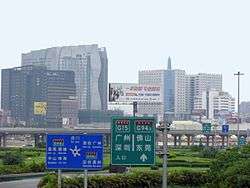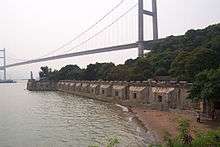Humen Town
| Humen 虎门镇 | |
|---|---|
| Town | |
 | |
 Humen | |
| Coordinates: 22°49′N 113°40′E / 22.817°N 113.667°E | |
| Country | China |
| Province | Guangdong |
| Prefecture | Dongguan |
| Population (2000) | 577,548 |
| Time zone | China Standard (UTC+8) |
Humen Town (Chinese: 虎门镇; pinyin: Hǔmén zhèn; Jyutping: Fu2mun4 zan3), formerly Fumun,[1] is a town in Dongguan city on the eastern side of the Humen strait on the Pearl River Delta, in Guangdong province, southern China. The former town of Taiping was incorporated into Humen Town in 1985. The population was 577,548 in the 2000 census, making it the second most populous town (zhèn) in China (after Chang'an in Dongguan as well).[2]
History

The history of Humen is linked to the First Opium War (1839–1842). It was at Humen that Lin Zexu supervised the destruction of large quantities of seized opium in 1839. Some major battles in the First Opium War were fought here and on the waters of the Bocca Tigris.
Economy
Humen is a thriving city crowded with consumer goods factories. These factories also fueled population expansion from emigrating workers around the country seeking factory jobs. Furthermore, Humen is geographically advantageous for the factories due to its proximity to two large metropolitan cities and export harbors of Hong Kong and mainland China's Shenzhen. Humen has long been an important gateway to south China. Going upstream, ships plying the Pearl River can reach the eastern, northern and western regions of Guangdong and even parts of Guangxi province. The main port, Humen Port, is a first-class port open to foreign vessels.
Tourist attractions

- The "Sea Battle Museum", which has dioramas and displays featuring the First Opium War and the Second Opium War, may be reached by taking number 8A or 8B bus to its westernmost stop.
- The Opium War Museum also known as the Lin Zexu Memorial Museum
- Former Residence of Jiang Guangnai
- Keyuan Garden (lit. "a garden not too bad for visiting"), built in 1850 during the Qing dynasty
Several Qing dynasty forts, including:
- Weiyuan Fort (simplified Chinese: 威远炮台; traditional Chinese: 威遠砲臺), located near the "Sea Battle Museum" and almost directly under the Humen Pearl River Bridge
- Shajiao Fort (simplified Chinese: 沙角炮台; traditional Chinese: 沙角砲臺); lit. "sand corner" fort), where the Convention of Chuenpi was signed in 1841 during the First Opium War
- Eyi Fort (simplified Chinese: 鹅夷炮台; traditional Chinese: 鵝夷砲臺)
- Jingyuan Fort
- Zhenyuan Fort
Travel

Humen is located at the eastern end of the Humen Pearl River Bridge.
Humen is served by regular direct buses traveling south from Guangzhou. Routes continue south by bus to Shenzhen's Window of the World theme park, from which it is possible to continue on to the Hong Kong border by bus or the Shenzhen Metro.
A ferry service connects Humen Ferry Terminal to Hong Kong International Airport.
References
- ↑ Postal romanization.
- ↑ National Bureau of Statistics of China; Guangdong (Chinese) Population of administrative units at the 2000 Population Census. Retrieved on 2010-04-25.
External links
| Wikimedia Commons has media related to Humen Town. |
- Human government website (Chinese)
- www.humen.com (English)
- Chinese Wikipedia article about the destruction of opium in Humen
- Opium War Museum website
- Shajiao Fort webpage: click on map
Coordinates: 22°49′N 113°40′E / 22.817°N 113.667°E